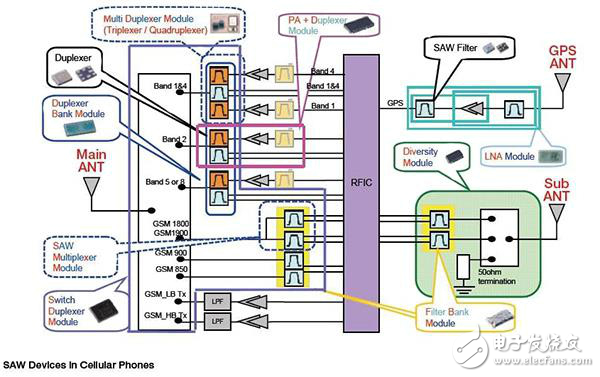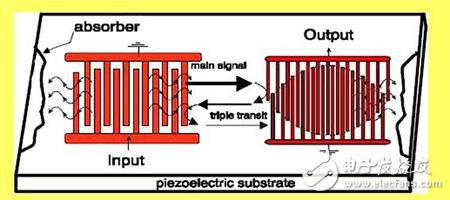资料介绍
SAW Filters Rescue Wireless Products from Impractical Discrete Implementations
作者:Bill Schweber
Filters have always been an essential component in the RF signal path. In the past, engineers had to become skilled in the complexities of filter-design theory and practice in order to create real filters based on discrete components. However, for today’s wireless devices and applications, the required filter specifications are increasingly difficult to meet using this approach as the RF spectrum gets more crowded and is sliced into smaller slivers, while operating frequencies increase well beyond the GHz threshold. The reality is that filters using discrete components cannot meet the performance, consistency (due to parasitics), size, and cost needs of many of today’s RF products.
Fortunately, monolithic-like devices such as surface acoustic wave (SAW) filters were developed over the last decades, and these provide the needed functions and features. With SAW filters, engineers are primarily concerned with selection of the filter as a single complete entity, instead of filter design. SAW filters offer a favorable combination of performance, size and cost, and are used extensively in applications embodying Wi-Fi, LTE, GSM, Bluetooth, and many other wireless standards.
A multiband smartphone can have ten or more SAW filters, fulfilling many roles: wideband, narrowband, passband, low pass, and high pass, at both the system -level, as well as in highly localized sub-circuits (Figure 1)。 As a result, the filter-related activity of engineers has shifted from working through a complex design and associated test/debug to, instead, the selection of a suitable, available filter (which is a good thing, to most engineers)。

Figure 1: SAW filters are used in quantity in wireless devices, for front-end filtering, narrow multiband filtering, and eliminating specific interference sources; they can be narrow or wide, with band-pass, low-pass, and high-pass FIR characteristics. (Courtesy of Taiyo Yuden)
SAW filter basics
A SAW device transforms the electronic RF-signal energy to mechanical energy in the acoustic domain. The filter is based on a piezoelectric material used as a substrate, such as quartz, lithium niobate, lithium tantalate, or lanthanum gallium silicate. Both ends of this substrate are capped with a sculpted metal layer as the electro-acoustic transducer, formed from comb-like fingers as an interdigital transducer (IDT), as illustrated in Figure 2.

Figure 2: Comb-like interdigital transducers at each end of the piezoelectric substrate convert impinging electrical energy to acoustic-mechanical energy, the energy wave then travels across the surface, where it is converted back to electrical energy by an IDT at the receiving end. (Courtesy of the University of South Florida)
The electrical signal is applied to one end of the device, converted to acoustic energy by the source IDT and launched across the piezo material’s surface, where it travels as surface-acoustic wave (called Rayleigh waves after Lord Rayleigh, who analyzed them in detail)。 The energy is then converted back to an electronic signal at the far end by a similar though not identical IDT, designed to capture the energy. Fortunately, the overall electrical/acoustic and complementary acoustic/electrical conversion processes are highly-efficient, reaching 99% or better; this helps maintain SNR and signal integrity.
The SAW filtering results from constructive and destructive interference, due to the wave delays which occur as the wave travels across the surface at between 3000 and 12,000 meters/second (depending on substrate material)。 The delayed outputs at the receiving end combine, yielding a finite-impulse-response (FIR) filter response. The acoustic energy’s propagation speed is far, far slower than electrical propagation, and thus has mechanically viable dimensions. By adjusting the travel distance and dimensions of the IDT fingers, and thus their impulse response, the standing-wave interference pattern of the SAW device establishes a desired filter center frequency, bandwidth, type, and other factors.
Note that the SAW is completely different in fundamental concept and implementation than a traditional all-electronic, RLC-based filter; it is not just an integrated-circuit, monolithic re-creation of the RLC-type
- 857145 声表面SAW滤波器的详细数据手册免费下载 9次下载
- 857193 725.5MHz声表面(SAW)滤波器的详细数据手册免费下载 0次下载
- 857190 2140MHz声表面(SAW)滤波器 11次下载
- 857217 742.5MHz声表面(SAW)滤波器的详细数据手册免费下载 5次下载
- 856815 1650.75MHz声表面(SAW)滤波器的详细资料免费下载 11次下载
- 856824 897.5MHz声表面(SAW)滤波器的详细资料免费下载 0次下载
- 856883 声表面SAW滤波器的详细资料免费下载 14次下载
- 856844 782MHz声表面(SAW)滤波器的详细数据手册免费下载 10次下载
- 856884 707MHz声表面(SAW)滤波器的详细数据手册资料免费下载 0次下载
- 856880声表面(SAW)滤波器的详细数据手册资料免费下载 6次下载
- 856934 1842.5MHz声表面(SAW)滤波器 13次下载
- 856604 SAW滤波器的详细资料免费下载 6次下载
- 856440 SAW滤波器的详细数据手册免费下载 11次下载
- 856717延迟线SAW滤波器的详细数据手册免费下载 17次下载
- 无线通信用SAW滤波器的分析与设计详解 9次下载
- 从谐振器到滤波器,简述SAW滤波器的设计过程 634次阅读
- 高频有源抗混叠滤波器 1005次阅读
- 滤波器的概念和结构 1174次阅读
- SAW滤波器的使用和匹配 2379次阅读
- 基于SAW滤波器的接收器设计 2585次阅读
- 什么是SAW滤波器技术,它的原理及技术特点是什么 3.1w次阅读
- 薄膜体声波滤波器的材料、设计及应用详细解析 1w次阅读
- SAW滤波器的现状及面临的挑战以及新型的IHP SAW滤波器介绍 2.5w次阅读
- 解决移动设备滤波的两种技术:SAW和BAW 3213次阅读
- SAW滤波器的用途及主要参数 4.9w次阅读
- SAW滤波器特性及内部结构 1.4w次阅读
- SAW和BAW滤波器的分析 10.1w次阅读
- 详细解析滤波器的定义,滤波器的特性,滤波器的工作原理,滤波器的分类,滤波器的典型电路原理图 1.4w次阅读
- 基于CMOS工艺的高性能射频滤波器:体声波滤波器BAW 3.9w次阅读
- 基于DSP的自适应滤波器的设计方案 7882次阅读
下载排行
本周
- 1电子电路原理第七版PDF电子教材免费下载
- 0.00 MB | 1489次下载 | 免费
- 2单片机典型实例介绍
- 18.19 MB | 92次下载 | 1 积分
- 3S7-200PLC编程实例详细资料
- 1.17 MB | 27次下载 | 1 积分
- 4笔记本电脑主板的元件识别和讲解说明
- 4.28 MB | 18次下载 | 4 积分
- 5开关电源原理及各功能电路详解
- 0.38 MB | 10次下载 | 免费
- 6基于AT89C2051/4051单片机编程器的实验
- 0.11 MB | 4次下载 | 免费
- 7基于单片机和 SG3525的程控开关电源设计
- 0.23 MB | 3次下载 | 免费
- 8蓝牙设备在嵌入式领域的广泛应用
- 0.63 MB | 3次下载 | 免费
本月
- 1OrCAD10.5下载OrCAD10.5中文版软件
- 0.00 MB | 234313次下载 | 免费
- 2PADS 9.0 2009最新版 -下载
- 0.00 MB | 66304次下载 | 免费
- 3protel99下载protel99软件下载(中文版)
- 0.00 MB | 51209次下载 | 免费
- 4LabView 8.0 专业版下载 (3CD完整版)
- 0.00 MB | 51043次下载 | 免费
- 5555集成电路应用800例(新编版)
- 0.00 MB | 33562次下载 | 免费
- 6接口电路图大全
- 未知 | 30319次下载 | 免费
- 7Multisim 10下载Multisim 10 中文版
- 0.00 MB | 28588次下载 | 免费
- 8开关电源设计实例指南
- 未知 | 21539次下载 | 免费
总榜
- 1matlab软件下载入口
- 未知 | 935053次下载 | 免费
- 2protel99se软件下载(可英文版转中文版)
- 78.1 MB | 537791次下载 | 免费
- 3MATLAB 7.1 下载 (含软件介绍)
- 未知 | 420026次下载 | 免费
- 4OrCAD10.5下载OrCAD10.5中文版软件
- 0.00 MB | 234313次下载 | 免费
- 5Altium DXP2002下载入口
- 未知 | 233045次下载 | 免费
- 6电路仿真软件multisim 10.0免费下载
- 340992 | 191183次下载 | 免费
- 7十天学会AVR单片机与C语言视频教程 下载
- 158M | 183277次下载 | 免费
- 8proe5.0野火版下载(中文版免费下载)
- 未知 | 138039次下载 | 免费
 电子发烧友App
电子发烧友App


















 创作
创作 发文章
发文章 发帖
发帖  提问
提问  发资料
发资料 发视频
发视频 上传资料赚积分
上传资料赚积分









评论